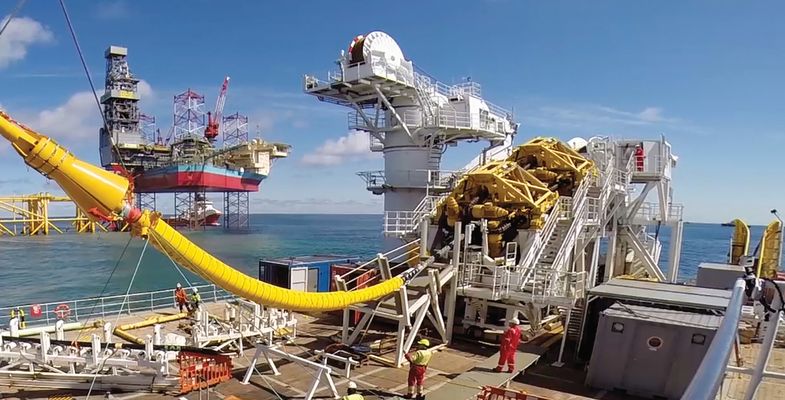ASTM G154 UV Resistance Testing of Offshore Cable Materials
The ASTM G154 method is a crucial standard used to assess the resistance of materials to ultraviolet (UV) light exposure. This testing is particularly important in the energy sector, especially when dealing with offshore platforms and subsea cables. The primary goal of this service is to ensure that the materials used in these environments are capable of withstanding harsh UV conditions without degrading, which can lead to costly maintenance or operational downtime.
UV radiation is a significant factor contributing to material degradation in offshore applications. Exposure to sunlight can cause photodegradation, leading to cracks, discoloration, and reduced mechanical properties over time. This service focuses on simulating the effects of UV radiation using artificial light sources that mimic solar UV-A and UV-B rays, providing insights into how materials will perform under real-world conditions.
The ASTM G154 method involves exposing specimens to a combination of xenon arc lamps and water spray for extended periods. The exposure is controlled to ensure consistency with the standard's requirements. This service ensures that offshore cable manufacturers can validate their product’s UV resistance before deployment, minimizing risks associated with premature failures in critical maritime infrastructure.
The testing procedure is designed to simulate the effects of direct sunlight on materials used in offshore applications. It helps identify potential issues early in the development process, allowing for necessary adjustments and optimizations. The results provide valuable data that can be used to improve product design and enhance durability, ensuring reliability in extreme environments.
Materials subjected to this testing include insulation layers, protective coatings, and structural components of subsea cables and offshore platforms. Understanding material performance under UV exposure is essential for maintaining the integrity of these structures over their operational lifetimes. This service ensures that the materials used are robust enough to withstand the environmental challenges encountered in marine environments.
ASTM G154 testing plays a vital role in quality assurance and compliance, ensuring that products meet or exceed industry standards. The test results can influence decisions regarding material selection, design modifications, and operational strategies for offshore installations. By leveraging this service, stakeholders can make informed choices about the materials they use, ultimately contributing to safer and more efficient operations.
The testing process is comprehensive and replicates real-world conditions, making it a reliable indicator of a material's durability in offshore environments. This ensures that the products developed are not only compliant with international standards but also capable of performing optimally under challenging environmental conditions.
Scope and Methodology
| Parameter | Description |
|---|---|
| Type of Exposure | Xenon arc lamps simulating solar UV-A and UV-B rays. |
| Exposure Duration | Typically up to 1000 hours, depending on the material's expected service life. |
| Water Spray | To simulate the effects of saltwater exposure in marine environments. |
The testing process involves rigorous quality control measures to ensure accurate and consistent results. This includes calibrating equipment regularly, maintaining controlled environmental conditions, and adhering strictly to the ASTM G154 standard. By following these procedures, we guarantee reliable data that can be trusted for decision-making purposes.
Use Cases and Application Examples
- Offshore Wind Turbine Cables: Ensuring that the insulation materials used in subsea wind turbine cables are UV-resistant to prevent degradation over their operational lifespan.
- Subsea Power Transmission Cables: Evaluating the performance of protective coatings and insulating layers under prolonged exposure to harsh environmental conditions.
- Offshore Platforms: Testing structural components for resistance against UV-induced aging, ensuring longevity in challenging marine environments.
ASTM G154 testing is a critical step in the development process of materials used in offshore applications. By identifying potential weaknesses early on, stakeholders can implement necessary changes to enhance product performance and reliability.
Competitive Advantage and Market Impact
| Advantage | Description |
|---|---|
| Enhanced Product Reliability | Achieving reliable test results ensures that products can withstand harsh environmental conditions, reducing the risk of failures and operational disruptions. |
| Compliance with Industry Standards | Testing according to ASTM G154 ensures compliance with international standards, providing a competitive edge in global markets. |
By offering this service, we help clients stay ahead of the curve in terms of material performance and durability. This not only enhances product reliability but also contributes to more sustainable and efficient operations in the energy sector.





